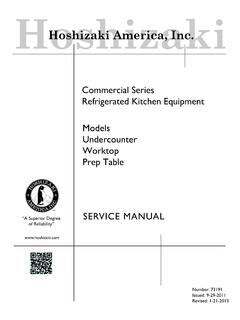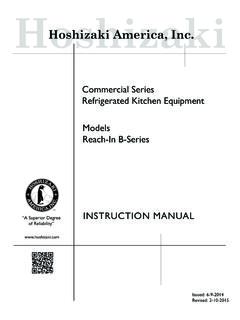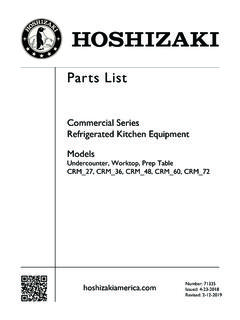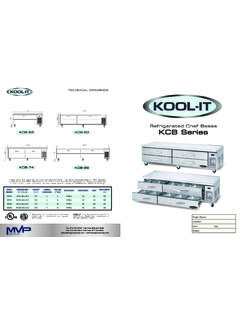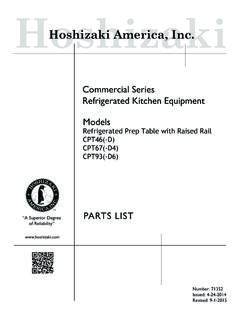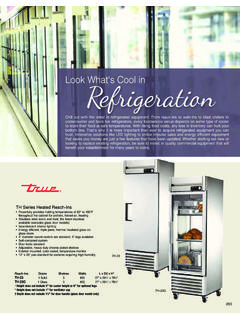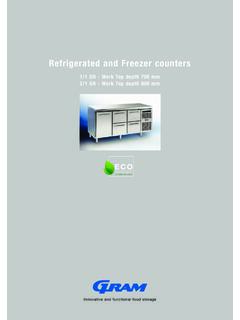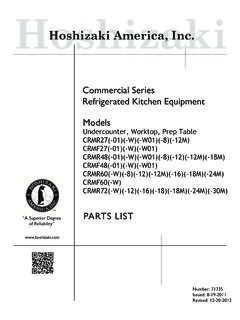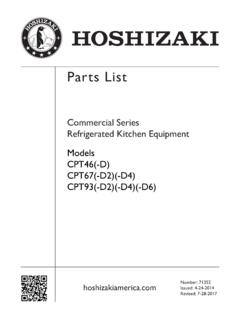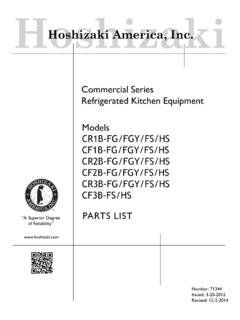Transcription of User Manual - avantcorefrigeration.com
1 User Manual commercial refrigerated Chef Base Manual 04/2016. refrigerated Chef Base Units CBE36, CBE52, CBE72. Please read the Manual thoroughly prior to equipment set-up, operation and maintenance. -1- User Manual Installation Important!!! Please Read Before Installation If the unit has recently been transported on its side, please let unit stand still for a minimum of 24. hours before plugging it in. Make sure that the unit drops down to desired temperature before loading the unit with product. Make sure that there is proper ventilation around the unit in the area where it will operate. Make sure all accessories are installed ( divider bars, casters) before plugging the unit in. Please read through the Manual in its entirety. Cabinet Location Guidelines Install the unit on strong and leveled surfaces - Unit may be noisy if surface is uneven.
2 - Unit may malfunction if surface is uneven. Install the unit in an indoor, well-ventilated area - Unit performs more efficiently in a well-ventilated area. - For best performance, please maintain clearance of 4 on the front and sides of the unit. - Outdoor use may cause decreased efficiency and damage to the unit. Avoid installation in a high humidity and/or dusty area - Humidity could cause unit to rust and decrease efficiency of the unit. - Dust collected on condenser coil will cause unit to malfunction. - Malfunction due to dirty condenser will void warranty. Select a location away from heat and moisture-generating equipment - High ambient temperatures will cause the compressor to overwork, leading to higher energy bills and gradual breakdown of the unit. The unit should not be used in areas over 90 degrees. - Malfunction due to high ambient temperature will void warranty.
3 - Equipment placed on top of the unit must be installed on manufacturer-supplied legs. Minimum clearance of 4 . between the top of the chef base and bottom of the cooking equipment. Electrical Please ensure that the required voltage of the compressor is being supplied at all times. Low or high voltage can detrimentally affect the refrigeration unit. All units should be plugged into a grounded and properly-sized electrical outlet with appropriate overcurrent protection. Please refer to the electrical requirements on the nameplate. Please make sure that your unit has its own dedicated outlet. Do not use an extension cord. -2- User Manual Temperature Controls Refrigerant LED - Compressor is on Fan LED - Fan is on Defrost LED - Defrost cycle is running Functions Adjusting the Temperature Refrigerators are programmed to operate between 33 and 40 degrees Fahrenheit.
4 To set the temperature you would like your unit to run at, follow these instructions: Hold SET for 1 sec. The display will flash the temperature that the refrigerator is currently set to run at. Use the arrow buttons to adjust the temperature you want it to run at. Press SET again to save your settings If the unit consistently runs 5 + degrees higher than your set temperature, service may be needed. Note: All other control functions should be performed by a service technician. Refrigerator Control mut e set CAUTION. Setting the temperature control to the coldest setting may cause the evaporator coil to freeze and ice up. This will eventually result in a warmer cabinet temperature. NOTE. Temperature controls on the refrigerated chef bases are located on the front of the units. -3- User Manual Running a Manual Defrost Cycle This unit is pre-programmed to run automatic defrost cycles at preset intervals.
5 However, if you would like to run a Manual defrost cycle at any time, please follow the steps below: Refrigerators: Press the defrost button (snowflake symbol and down arrow) for approximately 3. seconds. Repeat to stop the defrost cycle. Defrost Systems Refrigerator coils are kept below the freezing point (32 F). During compressor down-time, the evaporator fan continues to circulate air through the evaporator coil. This air circulation raises the coil temperature above the freezing point, melting any accumulated frost. Run-off water is drained into the evaporator pan and evaporated. Automatic defrost timers automatically initiate at pre-set intervals and for a pre-determined duration. Loading Food Pans Chef bases are designed to hold 4 deep food pans. Using the included divider bars, configure each drawer to best meet specific service needs.
6 Each drawer can hold a combination of full, 1/3, 1/6 or 1/9 pans as needed. -4- User Manual Safety / Warning Please pay close attention to the safety notices in this section. Disregarding these notices may lead to serious injury and/or damage to the unit. Attention To minimize shock and fire hazards, be sure not to overload outlet. Please designate one outlet for your unit. Do not use extension cords. Do not put your hands under the unit while it is being moved. When the unit is not in use for a long period of time, please unplug the unit from the outlet. After unplugging the unit, wait at least 10 minutes before plugging it back in. Failure to do so could cause damage to the compressor. Unplug Cord To minimize shock and fire hazards, please do not plug or unplug the cord with wet hands. During maintenance and cleaning, please unplug the unit.
7 Proper Grounding Required To minimize shock and fire hazards, make sure that the unit is properly grounded. Warning Do not attempt to remove or repair any component unless instructed by factory. Make sure that the unit is not resting on or against the electrical cord and plug. To minimize personal injury, do not hang on the drawers. Do not store any flammable and explosive gas or liquids inside the unit. Do not attempt to alter or tamper with the electrical cord. -5- User Manual Regular Maintenance WARNING: DISCONNECT POWER CORD BEFORE. CLEANING ANY PARTS OF THE UNIT. Cleaning The Condenser Coil For efficient operation, it is important that the condenser surface be kept free of dust, dirt, and lint. We recommend cleaning the condenser coil and fins at least once per month. Clean with a commercial condenser coil cleaner, available from any kitchen equipment retailer.
8 Brush the condenser fins from top to bottom, not side to side. After cleaning, straighten any bent condenser fins with a fin comb. Cleaning The Fan Blades and Motor If necessary, clean the fan blades and motor with a soft cloth. If it is necessary to wash the fan blades, cover the fan motor to prevent moisture damage. Cleaning The Interior of Unit When cleaning the cabinet interior, use a solvent of warm water and mild soap. Do not use steel wool, caustic soap, abrasive cleaners, or bleach that may damage the stainless steel surface. Wash drawer gaskets on a regular basis, preferably weekly. Simply remove drawer gasket from the frame of the door, soak in warm water and soap for thirty (30) minutes, dry with soft cloth, and replace. Check drawer gaskets for proper seal after they are replaced. Periodically remove the drawer divider bars from the unit and clean them with mild soap and warm water.
9 -6- User Manual Troubleshooting Compressor Not Running Fuse blown or circuit breaker tripped. Replace fuse or reset circuit breaker. Power cord unplugged. Plug in power cord. Thermostat set too high. Set thermostat to lower temperature. Cabinet in defrost cycle. Wait for defrost cycle to finish. Condensing Units Run For Long Periods of Time. Excessive amount of warm product placed in cabinet. Allow adequate time for product to cool down. Prolonged drawer opening or drawer ajar. Ensure drawers are closed when not in use. Avoid opening drawers for long periods of time. Drawer gasket(s) not sealing properly. Ensure gaskets are snapped in completely. Remove gasket and wash with soap and water. Check condition of gasket and replace if necessary. Dirty condenser coil. Clean the condenser coil. Evaporator coil iced over. Unplug unit and allow coil to defrost.
10 Make sure thermostat is not set too cold. Ensure that door gasket(s) are sealing properly. Cabinet Temperature is too Warm. Thermostat set too warm. Set thermostat to lower temperature. Airflow blocked. Re-arrange product to allow for proper air flow. Make sure there is at least four inches of clearance from evaporator. Excessive amount of warm product placed in cabinet. Allow adequate time for product to cool down. Fuse blown or circuit breaker tripped. Replace fuse or reset circuit breaker. Dirty condenser coil. Clean the condenser coil. Evaporator coil iced over. Ensure drawers are closed when not in use. Avoid opening drawers for long periods of time. -7- User Manual Warranty Information Units in this Manual are backed by a 1 year parts and labor warranty, with a 5 year warranty on the compressor. For warranty inquiries or service, first locate: The model number and cabinet serial number (located on the front of the unit, or inside the door jamb).
